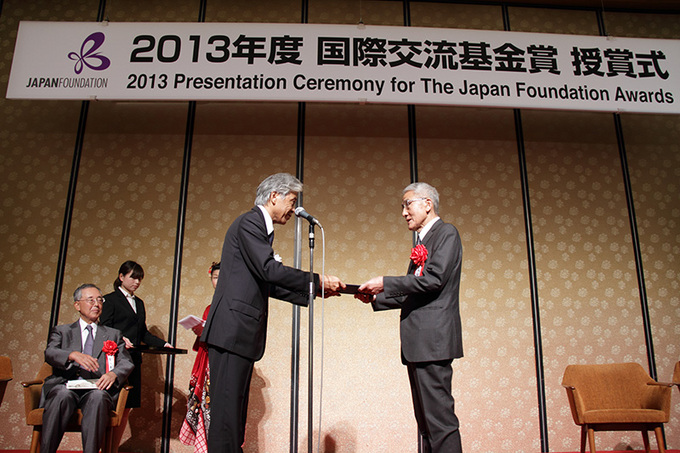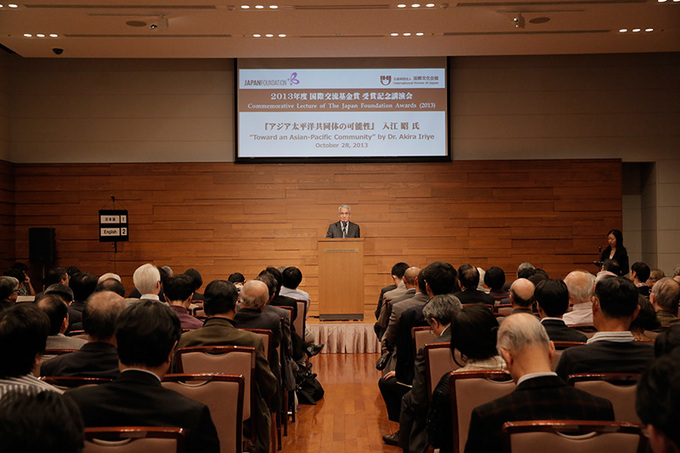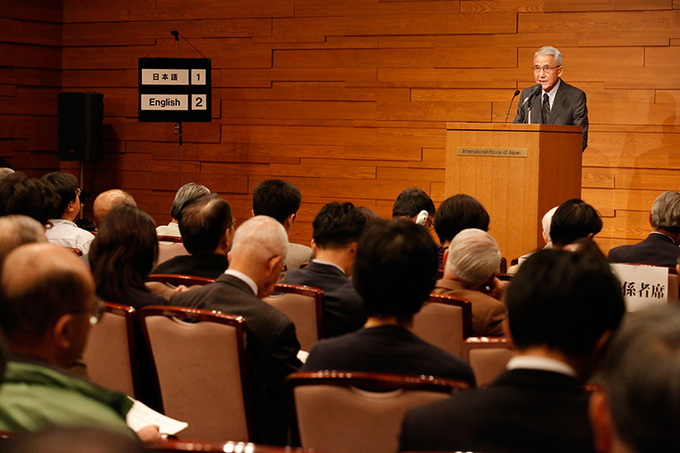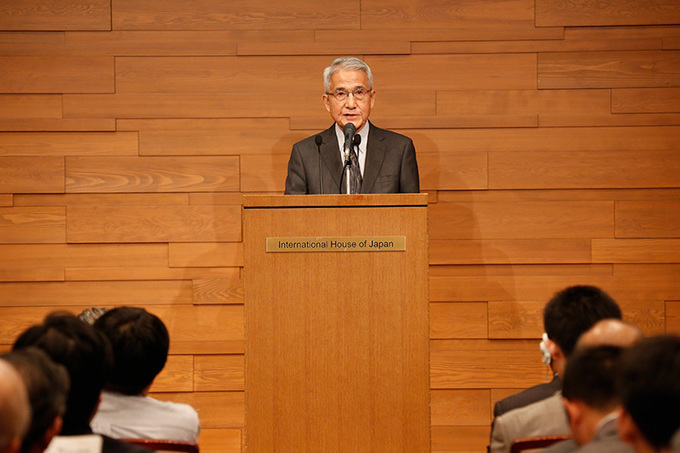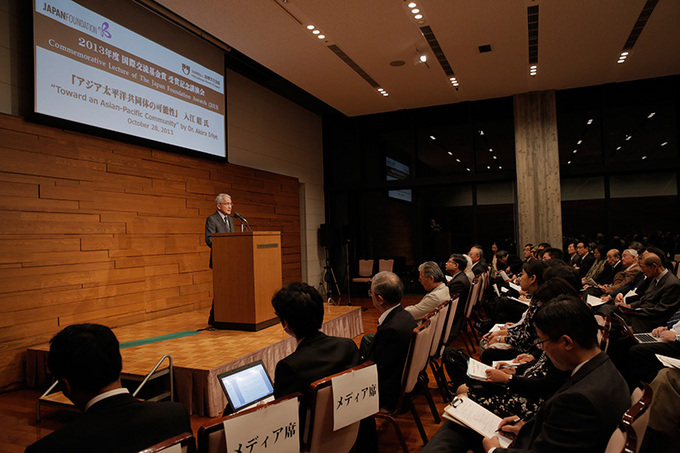Toward an Asia-Pacific Community
Akira Iriye
Professor Emeritus, Harvard University

2013 Presentation Ceremony for the Japan Foundation Awards
The possibilities of an Asia-Pacific Community
Some of you in the audience may be wondering, "why an Asia-Pacific Community now?" The concept of the Asia-Pacific as a region or a community has been discussed for quite some time; "Is there anything new to be said?" you may ask.
For people of my generation--I left Japan for the United States exactly 60 years ago, not long after the end of World War II--the term "Asia-Pacific" almost inevitably conjures up images of war and conflict. The tragedy of World War ll was immediately followed by the Cold War, the Korean War and the Vietnam War. But now the era of war is behind us, and my point of departure is the assumption that there is value in exploring the possibilities of an Asia-Pacific Community in more peaceful times.
The definition of an Asia-Pacific Community
Let me first clarify what I mean by an Asia-Pacific Community. For the purpose of this discussion I will use the word "Asia" to mean chiefly East and South East Asia and "the Pacific" for the countries of Pacific Rim from East and South East Asia to Australia and New Zealand, and on to North, Central, and South America. Thus, the "Asia-Pacific" encompasses all of these countries and regions.
There are at least two different ways to view the concept of an Asia-Pacific Community. One is to see it as a comity of nations or an assembly of sovereign states, such as China, Korea, Japan, the United States, Canada, and so forth. The European Union, formed in the 1950s, is a model for a community of this type. Another idea is to view an APC being as a community formed by ties among individual citizens or members of the private sector of the countries in the region.
I tend to take primarily the latter approach and see the Asia-Pacific region in terms of informal ties. One reason for this is that an Asia-Pacific Community as a community of nations is likely to be difficult to achieve. Among sovereign states in the Asia-Pacific region are mountains of issues--territorial, military and otherwise. Those responsible for foreign policy are charged with dealing with these issues, and there is a strong sense on the part of sovereign states that they cannot survive as such if they do not defend their national interests, rights, and territory. Because of this, I do not think it will be so easy for the nations in the region to unite or cooperate in various forms to create an Asia-Pacific Community. As a stepping stone for the future of the Asia-Pacific region, we should first strengthen ties among individuals and private sectors in the region. I think that it is a path or a prerequisite for the achievement of an Asia-Pacific Community in the future.
"Connections": A keyword for the APC in historical perspective
I am merely a historian. I am neither a specialist in contemporary issues, nor a commentator on current affairs. I do no more than study the past. So how can I, as a historian, make such a statement about the future with some conviction? It comes from a result of certain recent developments among the members of my profession: A growing interest in viewing history as something centered on the connections among human societies, rather than on nation-states. The key word is "connections" or "relations."
In fact, traditional historiography has tended to focus on nation-states. Recently, however, there has been an influential movement among historians to look at history from a perspective focusing on connections among human beings, and between people and the natural world that have existed since prehistoric times and the ways in which relations among people have become interconnected in different regions and individual societies.
Approximately ten years ago, for example, I, along with a German historian, was approached by American and German publishing houses with a proposal that we compile a six-volume history book to be titled A History of the World. Our team searched for ways to present the history of mankind in a new framework, and arrived at the idea to center on the history of human "connections."
People have tended to think of history as a story of progress from antiquity to the Middle Ages, to early modern and modern times and thus to the contemporary world, with Europe and America being the key actors. The Industrial Revolution and major political movements such as the democratic revolution all tend to be viewed from a Western-centered perspective.
But when we shift the focus to the history of "connections," we arrive at a vision of the world and its history that includes non-Western countries, such as Asia, Africa, and South America, which actually make up the majority of the world. We wanted to look at how people throughout the world gradually became interconnected with one another.
The fifth volume in this series, covering the history from the mid-19th to the mid-20th century, was published just last year. This is a period that is generally seen as a period of warfare, marked by imperialism and the clashes among the Western colonial powers. With the two world wars fought, one cannot deny that much of history during this period was shaped by conflicts and struggles. Focusing on that aspect alone, however, may present a risk of overlooking deeper connections running underneath the surface. So we titled this volume A World Connecting--the theme of the work as a whole. We are pleased that the new history book, highlighting the connections among human beings, has had the favorable reception in Germany and the United States, with reviews saying that it offers a new, different impression on the subject from previous works.
The sixth and final volume of the series, soon to be released, covers the period since the end of World War ll, the latter half of the 20th century. While many history books emphasize the Cold War as the central theme of this period, we are editing it with the idea that it would be interesting to explore the post-1945 history as a period of increasing mutual interdependence. Our work was guided by that idea, and the latest title is to be published shortly.
Thus, there is an increasing interest in centering on connections among individuals for the study of history. I think that this serves as a background to thinking of the Asia-Pacific Community in similar terms. Encouraged by this, I would like to consider the Asia-Pacific region, or any other region of the world, as a place where such human connections can be made, like the European Union today.
There are many different types of connections: we have economic, social, cultural and intellectual connections. While such connections have existed from the dawn of human history down to the present day, they have become increasingly pervasive since the 19th century, and have now, after another century of twists and turns, reached a very high level of development today. What I hope to examine today is how the Asia-Pacific region stands in the midst of such developments.
Prerequisites for the establishment of an Asia-Pacific Community
What economic, social and cultural connections have come into being or have the potential for coming into being, that might serve as prerequisites for the Asia-Pacific Community? This is the central theme for us at present.
Economic connections
We will begin with connections in the economic sphere. The Asia-Pacific region is of course involved as part of the globalization process, but looking at this in historical terms, until quite recently its influence on the globalization of the world economy has been less than one might expect. Before the early 20th century, the region, even including the United States, accounted for only about 25% of global trade. And of this quarter of world trade, the United States was responsible for 15%, while the share of world trade accounted for by Japan, China, Korea and Southeast Asia was a mere ten percent.
This began to change towards the end of the 20th century. By the year 2000, the region, which steadily began to expand its economic activities in the 1960s, reached the point where it accounted for 50% of global trade. This was astonishingly rapid growth. Moreover, in 1990 the combined income of the United States and Asian nations surpassed that of all the European countries. The region's increasing share of world trade has rapidly boosted its relevance, and this trend will probably continue. Also, economic connections among the Asia-Pacific countries are already close and getting even closer in the coming years.
What is notable here is the radically increasing importance of connections among individuals and corporations, as opposed to formal connections between nation-states. Economic ties are not forged by governments. Even in ostensibly socialist countries such as China, the role of individuals and corporations has become quite important. In all this, talking about globalization, it is not the nation that matters but individual creativity that is of consequence. The fact that in the IT sector for example, inventions by individuals or small groups have been rapidly spread throughout the world, suggests that we should take creative capacities of individuals quite seriously as engines for the developments of the global economy.
That is to say, in order to promote the world economy and strengthen economic connections within the Asia-Pacific region, the individual's home and educational environment must also be taken seriously. The key challenge, therefore, is to shape education and the environment in every nation of the Asia-Pacific in such a way as to encourage the development of individuals with a rich creativity.
Meanwhile, economic development is accompanied by the issues of environmental pollution and energy consumption. Assuming an Asia-Pacific Community is established, one of the primary factors that will determine its success will be the extent to which it implements environmental policies that transcend national boundaries. Our experience with the Great East Japan Earthquake has taught us that some issues cannot be solved by one nation alone; it must seek assistance and support from other countries. And such problems are likely to increase over time.
Social connections
At the simplest level, social connections are a result of the movement of people. Let us now consider how human relationships have formed in the Asia-Pacific region, distinct from purely economic factors.
In this region that contains a majority of the world's population, human connections have been built through transnational movements of people. The Asia-Pacific region is characterized by a diverse range of ethnicities, religions, and cultures, and we need to look at the movements and connections among people of the region that have come about through immigration, colonization, travel, and tourism. Have the encounters of people from varied backgrounds provoked conflicts and frictions, or have they produced positive relationships?
Transnational migration is essentially an issue of human rights. When people go to a different country to live and work, how are they received and treated by the country they have gone to? What kind of experiences did the majority of Asian migrants have in a foreign country? How about North Americans who have gone to live in Asia? These questions come down to the issue that involves the defense of human rights of people from different ethnicities.
There was much room for improvement in this area before the 1960s. The racial prejudice and restrictive immigration policies in countries with predominantly white populations such as the United States, Canada, Australia, and New Zealand inhibited the development of social connections across the Asia-Pacific region. Change came about after the 1960s, when these countries started to open up their borders and allowed Asian immigrants permanent residence. An increasing number of Asians settled in North America and Europe, while at the same time (though less rapidly) many of the Asian countries began to accept Europeans, Americans, Canadians, Australians, and others to live in their countries. I am hopeful that these trends will move us in the direction to create stronger social interconnections grounded in the mutual recognition and defense of fundamental human rights.
I should point out that racial issues are merely one dimension of the human rights challenge. There are numerous other issues we need to address, as articulated in the United Nations Declaration of Human Rights, concerning such matters as equal rights for women and how society can learn to accept and nurture people with physical or mental disabilities. And throughout the Asia-Pacific region we are faced with the increasingly serious problem of aging populations. I feel that a more positive, human rights-oriented approach to building social connections will, in all likelihood, facilitate the realization of an Asia-Pacific Community.
The growing presence of non-governmental organizations (NGOs) in the region may further support this approach. It is very encouraging to see the birth of numerous NGOs in Japan, Korea and China as well as in the United States. We need to deepen connections not just between nations, but at the individual level and the level of civil society, and it requires strengthening ties among NGOs, and that is in fact occurring. A diverse variety of NGOs devoted to human rights and the environment problems can be found even in China today. I believe that the possibilities for an Asia-Pacific Community will increase with the growth of NGOs in the region.
Cultural Connections
Next, I'd like to discuss cultural connections in the region. Is there an Asia-Pacific Community in the sense of a forum for intercultural dialogue and communication?
The Asia-Pacific region has a surprisingly long history of cultural exchange. Cross-border cultural exchanges between Asian nations dates back to ancient times, and cross-Pacific exchanges of Asian nations with the United States and Canada has been around since Japan's Meiji period. Remarkably, even before World War ll, the 1930s saw a variety of academic associations and educational conferences among the countries of Asia and North America.
For example, the Institute of Pacific Relations promoted dialogue among journalists, academics and students. These efforts continued even after the outbreak of the Sino-Japanese War, right up to the eve of hostilities between Japan and the United States. I think this continuity of cultural exchange was truly significant.
During the postwar period the United States and China had broken off their relations with one another, U.S. President Richard Nixon paid a visit to China, and even before diplomatic relations between the two countries were normalized, cultural exchanges were initiated. So cultural connections among the Asia-Pacific nations existed for longer than one might think, something I believe holds out hope for the future.
An intriguing aspect of the development of cultural connections is what could be called hybrid cultures, a phenomenon that emerges by a positive encounter and blending between cultures. Japan and the United States, for instance, have created a hybrid culture that is neither purely Japanese nor purely American. I think a through hybridization--of people, cuisine, clothing, or scholarship--is a good thing. This cultural hybridization improves the possibilities for an Asia-Pacific Community in the future.
Intellectual connections
Finally, I will talk about intellectual connections. Being a part of cultural connections, the concept relates to how people of different nations perceive and understand each other or their willingness to collaborate with each other. If we are to assume intellectual connections as one of the conditions for building an Asia-Pacific Community, we need to consider whether these connections have been made, or have the potential for being made.
The much-discussed problem of history also bears directly on this issue. One of the first questions to be answered in resolving the problem is: Can education be set free from a national framework? Successful intellectual bonding is unlikely to occur while each country confines its education to what is published inside and refuses to use textbooks other than their own. Some parts of Europe are already taking a step in this area: Schools in France and Germany, for example, are using the same history textbooks. It is crucial to create connections in the field of education by adopting new practices such as having teachers from another country, or developing and using the same textbooks.
Right now, it is difficult to see how Japan and China could agree on using the same history textbooks. However, I think it is important for us to recognize the possibility of forging such connections at the private-sector level, or through improving education at home. And I think that this is already happening to an impressive extent between the United States and Japan, and feel that it is important in the future for the Asia-Pacific region as a whole to share something like a common educational experience.
Scholarship is another realm that requires such commonality: there cannot be knowledge that is valid only in one country. Yet when it comes to the problems of history, different countries have different perceptions, as in the case of Japan and China. It is perfectly acceptable for individuals to have different opinions, which is a matter of historical interpretation, not of historical accuracy. The facts of where, what, when something happened, however, remain the same. There is only one history, whether they are viewed by someone from the United States, China, Africa or Turkey. And this objective history is something that must be held in common.
We historians engage in collaborative research with other historians to ensure that our research is valid for everyone, with the goal of reaching an understanding of past events that is acceptable to all. The study of history is the same as the study of science in this respect. No science can be valid only in a single nation, and the same is true of the humanities. Thus, what exists is the common history of mankind, throughout the globe.
Is there a common history that is shared across the entire Asia-Pacific region? No. There clearly is none at present. However, when I meet historians from Australia, Canada, China, and other countries, I find a fundamental attitude of engaging in collaborative study of the past and sharing findings with one another.
When the state gets involved, there is a danger that it will forbid publication of information that is against the nation's interests. We should not have such governmental interventions. We must conduct our research as free agents--as human beings, as citizens, and as historians--unswayed by nation-state affiliations. I am optimistic in this regard because the world's historians are increasingly aware of the value of this common bond and are working to strengthen it. No matter what political sentiments or governmental perspectives exist on history, history itself cannot be changed.
Conclusion
When considering the potential for interconnectivity in the Asia-Pacific region, I think we find that economic connections are already well-established, and that social and cultural connections are headed in the right direction as well. This leaves us the issue of forging intellectual connections not only between the scholars and academics but also between ordinary people. I think it is essential for people in general to show more interest in a shared history of mankind, of the nature, and of our planet.
At no other time in history have connections throughout the Asia-Pacific region been stronger than they are today. And so, if the people of every country in the region would put a little more effort into reinforcing their economic, social, cultural and intellectual connections at various levels, then we will see a rise in mutual interdependence throughout the region. Issues may remain in terms of interstate relations, national interests, national sovereignty and territory, but if we can strengthen connections in these other areas, I think we will increase the likelihood that an Asia-Pacific Community can be formed.
The present era is one of the strengthening of transnational connections. In this sense, I hope that the Asia-Pacific Community can be strengthened, and that in turn this will play a part in forging more intimate connections throughout the world as a whole.
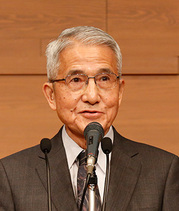 Akira Iriye
Akira Iriye
Professor Emeritus, Harvard University
Born in 1934, Akira Iriye moved to the U.S. in 1953 on scholarship from the Grew Bancroft Foundation after graduating from Seikei Senior High School. Iriye graduated from Haverford College in 1957 and received a Ph.D. in History from Harvard University Graduate School in 1961. He majored in American Diplomatic History. As a U.S.-based Japanese historian, Iriye has made significant contributions to his field over a long period of time. Iriye's approach is characterized by an emphasis on idealogical and cultural impact and he has proposed international history research that incorporates a multinational perspective that goes beyond research on the diplomatic history of one country and two-way interactions. Iriye is recognized as "one of the people who changed the way we view the diplomatic history of America." Iriye became the first Japanese citizen to serve as President of the Society for Historians of American Foreign Relations and as President of the American Historical Association and made a significant contribution as a pioneer in Japan-U.S. exchange.
Keywords
- Politics
- Economics/Industry
- Education/Children
- Social Securities/Social Welfare
- Natural Environment
- Philosophy/Religion
- History
- NPO/NGO
- The Japan Foundation Awards
- Cultural Diversity
- Peacebuilding
- Cultural Policy/Public Diplomacy
- East Asia
- Republic of Korea
- China
- Japan
- South East Asia
- Pacific
- Australia
- New Zealand
- North America
- Canada
- United States
- The Caribbean
- Latin America
- Germany
- France
- Harvard University
- Asia-Pacific Community
- Cold War
- Korean War
- Vietnam War
- Industrial Revolution
- Democratic revolution
- Imperialism
- World War l
- World War ll
- A World Connecting
- Globalization
- Environmental pollution
- Energy
- Great East Japan Earthquake
- Immigration
- Colonization
- Tourism
- Defense of human rights
- United Nations
- Gender equality
- Aging society
- President Richard Nixon
Back Issues
- 2025.6. 9 Creating a World Tog…
- 2024.10.25 My Life in Japan, Li…
- 2024.5.24 The 50th Japan Found…
- 2024.5.24 The 50th Japan Found…
- 2024.5. 2 People-to-People Exc…
- 2024.5. 2 People-to-People Exc…
- 2023.12. 7 Movie Theaters aroun…
- 2023.6.16 The 49th Japan Found…
- 2023.4.24 The 49th Japan Found…
- 2022.12.27 Living Together with…


